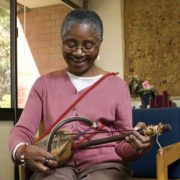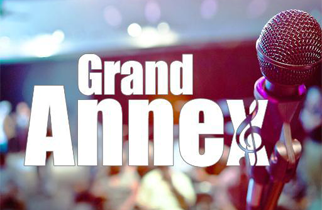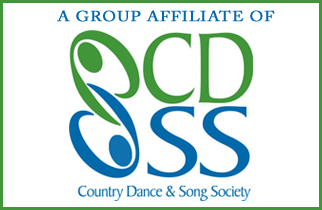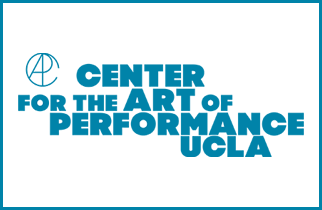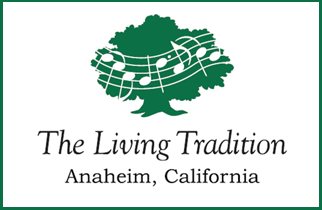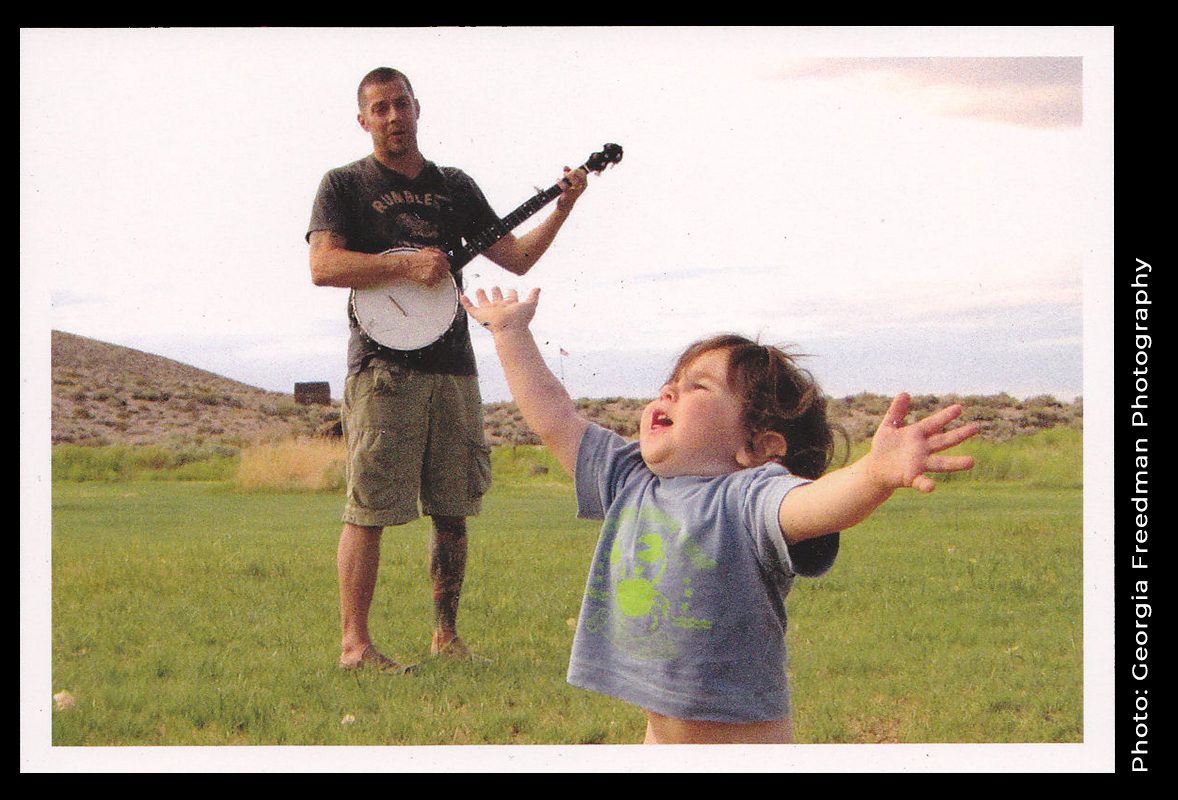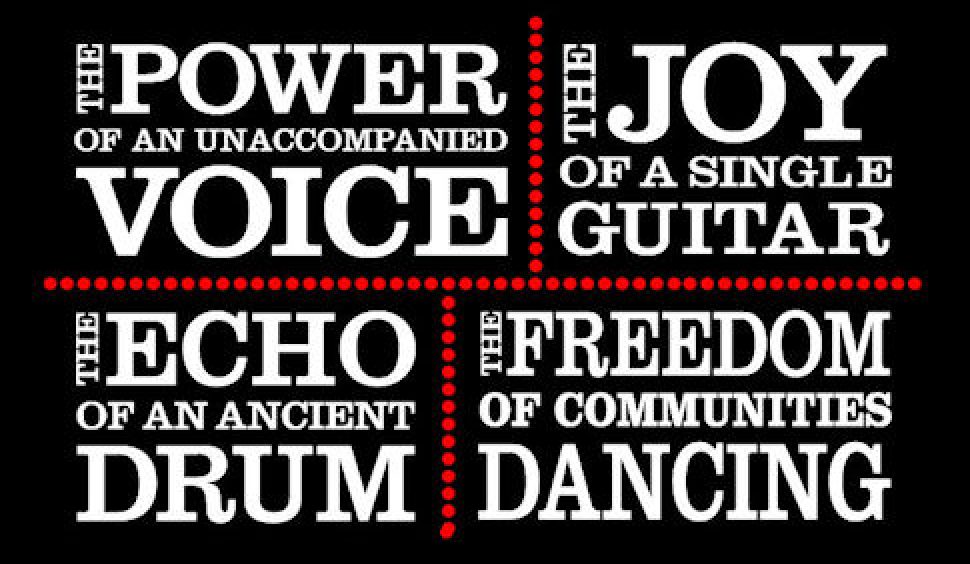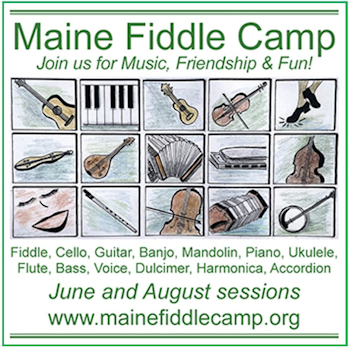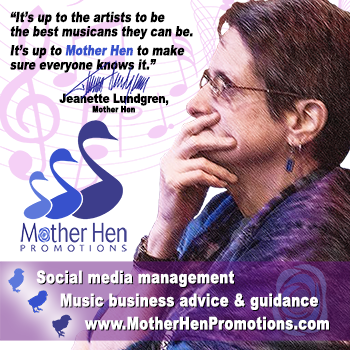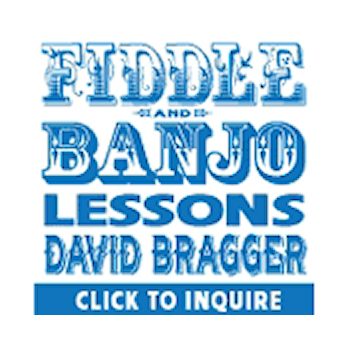Fiddling in West Africa
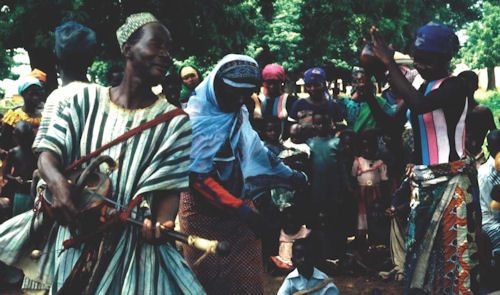
Salisu Mahama (Dagbamba fiddler) performing with musicians and dancers. Savelugu, Ghana, August 1990.
After procrastinating for over a month, I received news that ended my dilemma. In November, at the annual conference of the Society for Ethnomusicology (SEM) held in Mexico City, the SEM awarded Dr. Jacqueline Cogdell DjeDje the prestigious Alan Merriam Prize for outstanding scholarship for her book, Fiddling in West Africa: Touching the Spirit in Fulbe, Hausa, and Dagbamba Cultures (Indiana University Press, Bloomington, 2008). I had read the book not long before. It was an enthralling exploration of a little-known African musical tradition. In fact, I had just received the companion two-CD recording produced by the UCLA Ethnomusicology Archive. Immediately, I decided that instead of trying to convey the vast scope of the AMNA Symposium, I would share a single (though also multi-faceted) window on one of the many musics of Africa as revealed by one scholar-musician. I had already arranged an interview with Professor DjeDje (about the symposium). Instead, I engaged her in a conversation about a subject she has been investigating for over 30 years. In the process, I learned about the fervent work of an ethnomusicologist – seeking out musical examples among contrasting cultures, weighing and developing theories about the musicking she experienced, sharing her discoveries through presentations, publications, and recordings, and challenging common assumptions about Africans and their music.
AC: The fiddles you studied look very different from the instrument we’re used to seeing in folk music or orchestras here. What are the most basic features of an instrument that would allow you to call that instrument a fiddle?
Dr. DjeDje: The basics are that you need to have a stringed instrument with a neck that is bowed. You rub the bow across the string. In many parts of Africa, they use horsehair for the string and the bow.
AC: What is the earliest evidence of fiddling in West Africa?
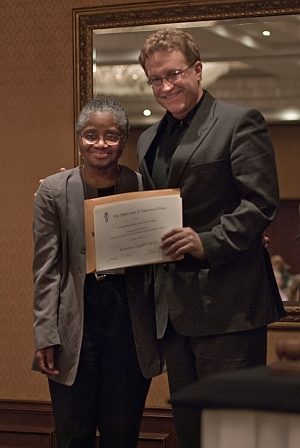
Jacqueline Cogdell DjeDje receiving
the Merriam Prize from Gage Averill, President, Society of Ethnomusicology, Mexico City, November 2009.
Dr. DjeDje: Some people suggest that it may go back to the 10th or 11th century A.D. in Africa and people connect this with the migrations of Arabs who migrated to North Africa. Actually, Arabs arrived earlier, around the 7th century, and they went up to Europe. And then when they were stopped by the Crusades, they began to focus more on Africa and began infiltrating various parts of West Africa. So many people don’t know that Arabs also introduced the fiddle tradition to Europe. Arabs introduced it to both groups – Africans and Europeans. And each group has used to develop something their own — in Europe and eventually the United States.
AC: I suppose that the origin of the violin has been conveniently forgotten in Europe and America.
Dr. DjeDje: People don’t recognize that the violin is actually from the Middle East, from Arab culture. In fact, the guitar, all these lute-type instruments are derived from the oud [a plucked lute].
AC: Considering this tradition was going on during the period of the slave trade and colonial times, why has so little been written and recorded about it?
Dr. DjeDje: I think it is because of what people expect of certain groups. I think Africa is generally represented as a drumming culture. So even when there were black fiddlers in the North America during the slave era, the people who wrote about them did not think the fiddle was something that represented Africa. They probably thought fiddling was an anomaly. It was only drums and percussion that they regarded as African.
AC: Did African slaves construct African fiddles?
Dr. DjeDje: They did. In fact, there’s evidence of gourd fiddles. There are some slave narratives in which slaves talk about the gourd fiddle. There’s a lot in the literature of the slave owners (commenting with surprise on how easily the slaves learned the violin) …Perhaps some of the enslaved knew the fiddle in Africa (so learning the European violin) was not so extraordinary for them.
AC: The way the fiddle came to West Africa seems to be a subject of controversy among Western academics as well as West Africans themselves, if I understand your book correctly.
Dr. DjeDje: I suppose there are some people who believe that the instrument is indigenous to the continent, but I would argue just the opposite. I think that wherever you find the instrument in any part of the world, whether it’s in Europe, the United States, or Southeast Asia, in most cases it was introduced by Arab culture. What people did with the fiddle after that initial introduction – credit should be given to those indigenous people. But in my opinion it came from Asia…and there are some people who argue about whether it originated in East Asia or Central Asia or West Asia. (laughs) Because origins are difficult to prove, ethnomusicologists don’t spend a lot of time discussing this now. Rather, it is more interesting to focus on how people developed the instrument after it was introduced.
AC: What are some of the reasons that an instrument from an outside culture will be incorporated into the fabric of a community?
Dr. DjeDje: To understand why some societies adopt an instrument, one has to look at how they use it within a particular context. Therefore, some people may have an affinity (for an instrument) because of their own personal preferences and what they are comfortable with. So, maybe people in the forest area of West Africa, because much of their musical traditions are percussion based, perhaps this kind of instrument (the fiddle) just didn’t fit that well. It did not link with what they were used to. Sometimes instruments are incorporated as symbols of power. So the king may introduce an instrument into his kingdom not because it satisfied his personal taste but because it is a symbol that "I came in contact with these people, or I conquered these people; therefore, this represents my domination over them" or the fact that "I am cosmopolitan." Sometimes people may adopt (an instrument) because they regard it as being something new. Maybe they see it performed and marvel at it and decide to incorporate it to appear more progressive.
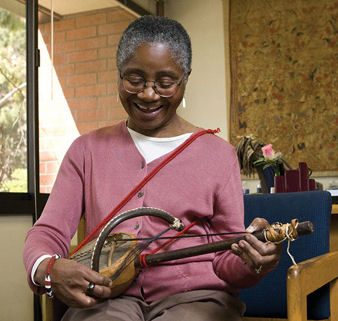
In addition to researching the West African fiddle, Dr. DjeDje chairs the Department of Ethnomusicology at UCLA.
AC: So, sometimes the newness or novelty would be viewed in a positive light.
Dr. DjeDje: It’s the same reasons why people here in the United States appropriate an instrument like the sitar, and you find some jazz musicians incorporating that. Maybe the sound is different but also appealing; some people are interested in religions from that part of the world and they see a link with that. Why did people create the trap drum set? This initially was not one instrument. But someone put it altogether, in my opinion, to duplicate a West African drum ensemble. You have the bell sound, the sonority, and various gradations of drums that produce a variety of high and low pitches. Early jazz musicians, who may have been some of the first to create and perform the trap drum set, put together instruments that they had seen four or five Africans performing. Since the early jazz musicians didn’t have (or want) that many people performing, they put the different drums together to create one instrument. This is sort of interesting because I’ve seen people in parts of West Africa – for example, the Dagbamba in Northern Ghana — perform the trap drum set. In Ghana, they’ve taken the trap drum set apart and they have three or four people performing it. (laughs) There are many different reasons why people may adopt an instrument.
AC: You chose three distinct groups in the Sudan to study. Can we use the term tribe to describe the groups?
Dr. DjeDje: I prefer not to use the term tribe.
AC: I didn’t think I saw it anywhere in the book.
Dr. DjeDje: If it was used, it is when I was quoting someone else.
AC: Does it have a connotation that you don’t care for?
Dr. DjeDje: Right. I don’t think it’s applicable in this particular case. I think some Africans use the term primarily because it was a term used during the colonial times-just like my father may use the word Negro or "colored" because when he was growing up, that’s what they used…But I think more and more people are recognizing that…many of the (peoples of Africa) were members of nation states. So (in the British Isles), would you think of the Scots as a tribe?
AC: I would consider them an ethnic group.
Dr. DjeDje: So that’s why I prefer to use the terms ethnic groups, peoples, or societies.
AC: You studied fiddle playing in the Fulbe, Hausa, and Dagbamba societies. Why did you choose these particular ethnic groups?
Dr. DjeDje: I was partial to the Dagbamba because that’s where it all began (for me)-with Salisu Mahama and my learning (fiddle) with him (at the Institute of African Studies in Ghana through its director, Professor Kwabena Nketia). I studied at the University of Ghana for about two years. Interestingly, after my first year, even though I am a pianist, when I learned the violin, I had to give a recital… In addition to the recital, I had to write a monograph. So I wrote this monograph and I thought, "Yes, I am the authority on the fiddle or the violin in West Africa." But (later) a friend from Nigeria who read my monograph (told me), "Don’t you know we have the same instrument in Hausaland in Northern Nigeria?" And I said, "No, I didn’t know about it." She told me about it and I said (to myself), "Okay, I can’t just call myself the authority on fiddles unless I know something about it." So I stayed in West Africa another year and I went to Northern Nigeria and spent some time there. The way they use (the fiddle), the way it’s constructed, the type of music they perform is totally different (from the Dagbamba people)… In my effort to try and get at the truth, I wrote my dissertation, comparing the fiddle traditions of the Dagbamba and the Hausa of West Africa.
AC: How did the Fulbe become incorporated into the book?
Dr. DjeDje: In the 1990s, when I decided that I wanted to do a study examining the fiddle cross-culturally, I had heard from someone in Senegambia that the instrument is found in Senegambia. They were referring to the Wolof people of Senegal. So I thought maybe I should investigate. It’s very far away from Nigeria and Ghana… I was able to get the funding to go there and lo and behold, I see a totally different tradition – its construction and use were different. At the same time, I was writing an article for the Garland Encyclopedia of World Music and they asked me to prepare the article on West African (music). This forced me to look at Africa as a whole and come up with some sense on why certain musics are found in this place and that place. As a result of that, I discovered that there are major distinctions between music of people live who on the coast (Atlantic Coast) and also major differences between people who live in the savannah and desert.
AC: It must have gotten harder and harder to generalize about fiddling in West Africa.
Dr. DjeDje: So I thought that it needed to be acknowledged that we couldn’t just say "West Africa" and assume everyone does drumming the way people in Ghana do drumming. At the same, I began to see differences in the culture due to interactions of various ethnic groups living in Senegal (the Western Sudan) and in Nigeria (the Central Sudan), where the Hausa live. I said, "Okay, maybe we need to recognize the differences and not generalize by stating, "all savannah people are the same, they’re all influenced by Islam, they’re all Arabs and that’s that." So once I became cognizant of those major differences in musicking generally, this helped me to understand fiddling. I also believed that if I did something on fiddling, I needed to choose a representative tradition from some of these different areas and let that tell the story of fiddling in West Africa.
AC: How did the word musicking come into being among ethnomusicologists?
Dr. DjeDje: This is a word invented by Christopher Small (who is originally from New Zealand and the author of the book, Music of the Common Tongue). Scholars often use the word because it explains what a lot of musical groups do. African American performance not only includes music, but the movement (interacting) and the whole experience are integral. All of that together (sound, movement, visuals, etc.) is represented into the word musicking.
AC: Can you give me an example of the ways the ethnic groups you studied musick with the fiddle?
Dr. DjeDje: Yes. There are some commonalities. Fiddles can all be played solo, and each tradition has different scales, a different way to improvise, and so on. But fiddles are (mainly) played within ensembles. If we look at (fiddles) as ensemble instruments, the other instruments included in those ensembles (vary from culture to culture). With the Dagbamba tradition, their fiddle is always played with a rattle (accompaniment). These are shaking rattles. So if you hear a fiddle and rattle together, immediately you would know that this is Dagbamba music. Now, to go to the Fulbe, they normally use the fiddle with another kind of gourd instrument, but they never shake it. It’s a different kind of percussion. Performers strike big half gourds with rings they have on their fingers. Later on, Fulbe began to include drums. They sometimes use the tama, an hourglass pressure drum that has a high, high pitch… So the fiddle, along with those rings (striking the gourds) and the tama, give (Fulbe) music a very distinctive sound that is very different from the Dagbamba sound.
AC: And the Hausa?
Dr. DjeDje: Then if you go over to Nigeria among the Hausa, they play the fiddle in a way that is much more complex than the other two. They tend to use drums (in the ensemble), too, but the sound of the drum is very different from what you would hear from the musicians in Fulbe culture. There’s a film that I recorded of a drummer playing in the ensemble. They perform two hourglass pressure drums together (or at the same time); one is attached to the thigh (and the foot) and the other is held underneath their arm. So the drummer goes back and forth hitting the two drums to make the drum sound. So, to me, the way the instruments are organized in ensembles, those are the distinguishing features that help you to understand the differences.
AC: You gave subtitles to the chapters on each of the three peoples. For the Fulbe, your subtitle was An Affirmation of Identity. What are some of the ways fiddling-what they call nyanyeru-affirms Fulbe identity?
Dr. DjeDje: It is their primary instrument. When you go to Senegambia, it’s sort of different from being among the people in Ghana or the people in Nigeria where there are very clear distinctions among ethnic groups. In Ghana, one would say, "I am Asante, I am Ga, I am Dagbamba," and there is this complex culture that surrounds who you are. It’s almost like people in the United States stating, "I am an African-American" and that means something, or "I am a Euro-American," or "I am an Asian-American." So there is a lot of "stuff" that goes along with who you are. But in Senegambia it’s difficult, because many of the cultures are closely linked with each other. So sometimes they might say, "I am a Gambian" or "I am from Senegal," instead of stating their ethnicity. Many Senegambians have intermarried with one another. The father might be Wolof, the mother might be Fulbe, and there may be a Mande in the family.
AC: The major distinctions between the people in that area are not so clearly defined.
Dr. DjeDje: So, what people do to mark their identity, especially when they are at major events and major festivals, they use musical instruments. For example, if someone is playing the kora [harp] or the bala [xylophone], automatically you know that that is Mande. Other people may play it, but it’s known to be a Mande tradition…The fiddle is what distinguishes the Fulbe. It affirms who they are. In that kind of pluralistic society, it seems that the fiddle is what makes the Fulbe people musically different from the Mande and the Wolof and so on.
AC: I remember from the book how fiddle music is played on the Fulbe radio station and you would find the fiddle at life cycle events such as weddings.
Dr. DjeDje: And when you have puberty ceremonies, there would be Fulbe fiddle players (performing there).
AC: It was fascinating to find out that some of the prominent fiddlers also performed as acrobats and one you saw was a fire eater.
Dr. DjeDje: I saw that. It was amazing. Nothing happened to him. Samba Juma Bah was known even more as a fire-eater than a fiddler. He was the only fiddler in the ensemble. The other musicians played the gourds with the rings or the drums and did acrobatics. In performance, each musician went to the center front (of the half circle) and demonstrated what he knew best. The person who played the gourds performed acrobatics with the gourds, putting them on the ground and turning somersaults.
AC: For the Hausa in Central Sudan, you focused on the role of the goge player in spirit ceremonies. Would you describe a ceremony you saw and what the fiddler’s role was?
Dr. DjeDje: The ceremony I saw was open to the public. I guess the people went into trance but you don’t know (for sure). I was told that when people are paid, they go into trance and if they’re not paid, they don’t go into trance. From what people have described to me, the private ceremonies are religious ceremonies that people participate in to deal with problems they have. So someone may decide that a Bori ceremony is needed, and they hire musicians. The musicians play a (sequence of songs), then certain individuals begin dancing in the ceremony. Normally it’s the females who dance although people don’t normally acknowledge this. (The females) are the ones who eventually go into trance during the ceremony. Each of them is taken over by a (particular) spirit, so when the music of that spirit is performed, the spirit takes over that individual, that medium. So that person begins moving and doing things associated with a particular spirit. (For example), if the spirit is associated with water and the music played is near water, you may find that person going to the creek or the river or a person who is helping that medium will bring that medium some water. And they will drink it or it will be poured over their body. Or if a spirit is associated with power, they may be put metal objects into their mouths and it’s not supposed to harm them.
AC: Is there a religious leader that’s coordinating what’s going on?
Dr. DjeDje: Yes and no. Because I’ve never gone to a real one…and only attended one of the more public ones, the person who seemed to be in charge was the head musician – in this case, the head fiddler. And so the head fiddler would play the music and look at the people who are dancing and try to understand whether they (the musicians) should go to another song or perform that particular song until whatever needs to happen, happens. So, basically, it’s the call of the spirit. And once the spirit comes, it helps the individual to deal with whatever is causing problems for that person. They may be physical problems, emotional problems, or economic problems…
AC: I read in your book that the fiddle was banned after the civilian government in certain states adopted Sharia law. Was it so threatening?
Dr. DjeDje: Some Northern Nigerians saw the fiddle as a symbol of the (indigenous) religion. And they thought if they got rid of that symbol, the religion would die out. It became a symbol of "the profane." Of course, what people told me was that the ceremonies continued to take place in hiding…
AC: Has that ban continued?
Dr. DjeDje: I believe so. When I was there in 2003, (the ban was still in force).
AC: If I understand right, the Dagbamba fiddlers in Dagbon [the name of the political kingdom] were in service to the king of the village, the Ya Naa, and were mainly engaged in praise songs for the king and singing proverbs.
Dr. DjeDje: The Dagbamba like proverbs and musicians often integrate them into praise songs for royalty. More recently, fiddlers have begun (composing) praise songs for ordinary people.
AC: Can you explain how the fiddle became embroiled in conflicts called the Yendi Skin Crises?
Dr. DjeDje: It had to do with the person who was the Ya Naa at that time. The fiddler is considered to be the "wife" of the king. In this case, you only had one wife. The fiddler is the only person who can play for the king in his private quarters while he is lying down. So there’s always only one head fiddler in a village or town. There was a Ya Naa who came into office in 1968, but there were some people in Dagbon who didn’t believe this person should be the Ya Naa, because they [the Dagbamba] had this rotating (system).
AC: So it was not hereditary.
Dr. DjeDje: It is hereditary but there are two different groups or clans within the royal family that hold the position, rotating back and forth… In 1968, one of the kings died and the next king came from the same clan as the person who died. So the other clan said that’s not fair. Yet, the person who was king in 1968 chose his head fiddler and the two of them became "married." Eventually Ghana’s federal government got involved, and after several years of deliberation, government leaders determined that the kingship should go to the other clan. However, the fiddler would not honor or perform music for the new king and it caused a big mess… Eventually this new king whom the government decided should have the kingship was killed and his palace was burned. I knew him. I was there when he was inaugurated. So the fact that the head fiddler never accepted the new king reflected the opinions of many in the community.
AC: How did this affect the status of fiddling in the village?
Dr. DjeDje: When I was there in 2007, all music in the village had been banned because the government did not want any fighting amongst the people. They saw that aligning with the music was so powerful that they just banned it.
AC: This included all instruments, not just the fiddle.
Dr. DjeDje: Everything. In 2007, they were still trying to work it out. The problem now is who is going to be the next king. (The family members of the Ya Naa) who was chosen by the government and was killed, believe that it is his son who should have the opportunity to be king. And since the fiddlers have no reason to perform the music, this means that the young people are not learning the music and no longer is fiddling very important.
AC: That’s affecting a whole generation. What do you predict for the future of fiddling in West Africa?
Dr. DjeDje: I think it is going to be something that people remember as part of their heritage. So at certain events, they will bring it out and perform it. It’s almost like in African-American culture, you have Black History Month, a time when different events, music, and other kinds of activities are organized to celebrate Black History Month. Whereas after the month ends, these activities may or may not happen. Among the Dagbamba, especially, whenever there is a special event (for example, a celebration comparable to what we call Christmas), they will probably hire musicians to perform during that event to remember the way things were. It’s kind of similar to what the Fulbe are doing now. Fiddling is performed on special occasions — at puberty ceremonies or a politician may request it, but not (part of everyday life) in the culture.
AC: Has some Peter Gabriel-type figure emerged to bring West African fiddling into fusion projects with Western music?
Dr. DjeDje: Actually that is happening. Juldeh Camara, one of the fiddlers I featured in the Fulbe chapter, now lives in London and has begun playing and recording with a very well known pop/rock/folk musician (British guitarist Justin Adams) in London. Juldeh records and tours Europe. You can find him on YouTube. He has his own website. He was the youngest fiddler I featured and the most progressive in his thinking.
AC: He was the one who addressed you in his song. I remember hearing that on the CD. I will try to find his music. Thank you for sharing some of your discoveries of fiddling in West Africa and congratulations on winning the Alan Merriam Prize from the Society for Ethnomusicology.
Dr. DjeDje: Thank you. It was quite a surprise to me.
Audrey Coleman is a writer, educator, and passionate explorer of world music and culture.

